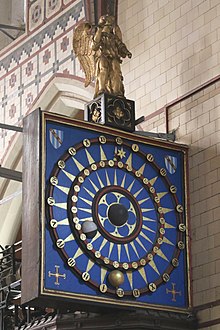Ottery St Mary astronomical clock


Ottery St Mary Astronomical Clock is a 14th-century astronomical clock in St Mary's Church, Ottery St Mary, in Devon in south-west England.
History and description
[edit]The south transept of the church of St Mary in Ottery St Mary houses the astronomical clock,[1] one of the oldest surviving mechanical clocks in England. It is commonly attributed to Bishop John de Grandisson, who was Bishop of Exeter (1327–69), and adheres to Ptolemaic cosmology with the Earth at the centre of the solar system.[2]
At the centre of the dial, the Earth is represented by a black ball. The Sun is represented by a gold ball which rotates round the outermost ring of the dial, showing the time. The Moon is represented by a ball which is half white and half black, which turns on its axis to show the phases of the moon. This ball rotates around the middle ring of the dial, numbered to show the days of the lunar month. The clock is similar in its display to the Exeter Cathedral astronomical clock in Devon and the Wimborne Minster astronomical clock in Dorset.[citation needed]
After 30 years of silence, the Ottery St Mary clock was restored to working condition in 1907[3] by John James Hall FRAS of Exeter. The rededication service, on 20 May 1907, was attended by the Bishop of Exeter, Archibald Robertson, who formally set the clock going.[4]
References
[edit]- ^ Nikolaus Pevsner, The Buildings of England, Devon (1952; 1989) (rev. Bridget Cherry) ISBN 978-0-300-09596-8
- ^ Whitham, J. A. The Church of St Mary of Ottery in the County of Devon: a short history and guide.
- ^ "Curious astronomical clock in Ottery St Mary church Church". Manchester Courier and Lancashire General Advertiser. Manchester. 29 March 1907. Retrieved 14 September 2015.
- ^ "Visit to Devonshire. Interesting Proceedings". Exeter and Plymouth Gazette. Exeter. 21 May 1907. Retrieved 14 September 2015.

